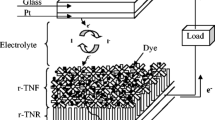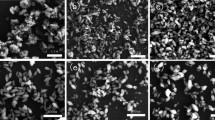Abstract
TiO2 nanorods have been prepared by hydrothermal method at 170 °C for 24 h and successfully implemented in a stable solar cell as a photoanode material to replace the conventional nanoparticles which cause the recombination reactions at the interfaces due to a large number of grain boundaries. The synthesized products are characterized by powder X-ray diffraction, Raman and transmission electron microscopy analysis. The performance of the nanorods employed solar cell has been studied under the irradiance of 100 mW/cm2. The fabricated device showed a power conversion efficiency of 5.42%. The open-circuit voltage, short-circuit current density and fill factor of the device are 0.647 V, 13.64 mA/cm2, and 61.5%, respectively. The electrochemical behavior of the fabricated device has been analyzed with electrochemical impedance spectroscopy. The lifetime of the injected electrons in the photoanode network has been found to be 10 ms, which was evaluated from Bode phase plot. From the Nyquist plot of the impedance spectrum, lower charge transfer resistance (Rct) has been observed at the TiO2/dye/electrolyte interface. The sealed device was monitored frequently with 500 h of the interval. Up to 2500 h, no significant drop has been observed in the J–V characteristics.









Similar content being viewed by others
References
B. O’Regan, M. Graetzel, A. Low-Cost, High-efficiency solar cell based on dye-sensitized colloidal TiO2 films. Nature 353, 737–740 (1991)
M. Graetzel, Recent advances in sensitized mesoscopic solar cells. Acc. Chem. Res. 42, 1788–1798 (2009)
S. Mathew, A. Yella, P. Gao, R. Humphry-Baker, B.F. Curchod, N. Ashari-Astani, I. Tavernelli, U. Rothlisberger, M.K. Nazeeruddin, M. Graetzel, Dye-sensitized solar cells with 13% efficiency achieved through the molecular engineering of porphyrin sensitizers. Nat. Chem. 6, 242–247 (2014)
K. Kakiage, Y. Aoyama, T. Yano, K. Oya, J-I Fujisawa, M. Hanaya, Highly-efficient dye-sensitized solar cells with collaborative sensitization by silyl-anchor and carboxy-anchor dyes. Chem. Commun. 51, 15894–15897 (2015)
P. Docampo, S. Guldin, U. Steiner, H.J. Snaith, Charge transport limitations in self-assembled TiO2 photoanodes for dye-sensitized solar cells. J. Phys. Chem. Lett. 4, 698–703 (2013)
M.J. Bierman, S. Jin, Potential applications of hierarchical branching nanowires in solar energy conversion. Energy Environ. Sci. 2, 1050–1059 (2009)
L. Hu, S. Dai, J. Weng, S. Xiao, Y. Sui, Y. Huang, S. Chen, F. Kong, X. Pan, L. Liang, K. Wang, Microstructure design of nanoporous TiO2 photoelectrodes for dye-sensitized solar cell modules. J. Phys. Chem. B 111, 358–362 (2007)
T. Berger, T. Lana-Villarreal, D. Monllor-Satoca, R. Gomez, An electrochemical study on the nature of trap states in nanocrystalline rutile thin films. J. Phys. Chem. C 111, 9936–9942 (2007)
J. Qu, G.R. Li, X.P. Gao, One-dimensional hierarchical titania for fast reaction kinetics of photoanode materials of dye-sensitized solar cells. Energy Environ. Sci. 3, 2003–2009 (2010)
H. Li, Q. Yu, Y. Huang, C. Yu, R.-Z. Li, J. Wang, F. Guo, Y. Zhang, X. Zhang, P. Wang, L. Zhao, Ultra-long rutile TiO2 nanowire arrays for highly efficient dye-sensitized solar cells. ACS Appl. Mater. Interfaces 8, 13384–13391 (2016)
E. Ghadiri, N. Taghavinia, S.M. Zakeeruddin, M. Graetzel, J.-E. Moser, Enhanced electron collection efficiency in dye-sensitized solar cells based on nanostructured TiO2 hollow fibers. Nano Lett. 10, 1632–1638 (2010)
I. Ahmed, A. Fakharuddin, Q. Wali, A.R.B. Zainun, J. Ismail, R. Jose, Mesoporous titania–vertical nanorod films with interfacial engineering for high-performance dye-sensitized solar cells. Nanotechnology 26, 105401 (2015)
W.-Q. Wu, B.-X. Lei, H.-S. Rao, Y.-F. Xu, Y.-F. Wang, C.-Y. Su, D.-B. Kuang, Hydrothermal fabrication of hierarchically anatase TiO2 nanowire arrays on FTO glass for dye-sensitized solar cells. Sci. Rep. 3, 1352 (2013)
Y.M. Liu, M.L. Zhang, Y. Jiang, Y. Xia, W.W. Sun, X.Z. Zhao, General strategy to construct hierarchical TiO2 nanorod arrays coupling with plasmonic resonance for dye-sensitized solar cells. Electrochim. Acta 173, 483–489 (2015)
T. Zeng, H. Ni, X. Su, Y. Chen, Y. Jiang, Highly crystalline titania nanotube arrays realized by hydrothermal vapor route and used as front-illuminated photoanode in dye-sensitized solar cells. J. Power Sources 283, 443–451 (2015)
A. Kumar, A.R. Madaria, C. Zhou, Growth of aligned single-crystalline rutile TiO2 nanowires on arbitrary substrates and their application in dye-sensitized solar cells. J. Phys. Chem. C 114, 7787–7792 (2010)
Z. Yang, D. Pan, C. Xi, J. Li, J. Shi, F. Xu, Z. Ma, Surfactant-assisted nanocrystal filling of TiO2 nanotube arrays for dye-sensitized solar cells with improved performance. J. Power Sources 236, 10–16 (2013)
J. Zhang, S. Li, H. Ding, Q. Li, B. Wang, X. Wang, H. Wang, Transfer and assembly of large area TiO2 nanotube arrays onto conductive glass for dye-sensitized solar cells. J. Power Sources 247, 807–812 (2014)
S.H. Kang, H.S. Kim, J.-Y. Kim, Y.-E. Sung, An investigation on electron behaviour employing -aligned vertically TiO2 nanotube electrodes for dye-sensitized solar cells. Nanotechnology 20, 355307 (2009). (6 pp)
K. Zhu, N.R. Neale, A. Miedaner, A.J. Frank, Enhanced charge-collection efficiencies and light scattering in dye-sensitized solar cells using oriented TiO2 nanotubes arrays. Nano Lett. 7, 69–74 (2007)
O.K. Varghese, M. Paulose, C.A. Grimes, Long vertically aligned titania nanotubes on transparent conducting oxide for highly efficient solar cells Nat. Nanotechnol 4, 592–597 (2009)
M. Adachi, Y. Murata, J. Takao, J. Jiu, M. Sakamoto, F. Wang, Highly efficient dye-sensitized solar cells with a titania thin-film electrode composed of a network structure of single-crystal-like TiO2 nanowires made by the ‘oriented attachment’. Mech. J. Am. Chem. Soc. 126, 14943–14949 (2004)
X. Feng, K. Zhu, A.J. Frank, C.A. Grimes, T.E. Mallouk, Rapid charge transport in dye-sensitized solar cells made from vertically aligned single-crystal rutile TiO2 nanowires. Angewandte Chemie—International Edition 51, 2727–2730 (2012)
K.-W. Lee, M. Kim, J.-M. Kim, J.J. Kim, I.-H. Lee, Enhanced Photovoltaic Performance of Back-Illuminated Dye-Sensitized Solar Cell Based on TiO2 Nanoparticle/Nanowire Composite Film in Cobalt Redox System. J. Alloy. Compd. 656, 568–572 (2016)
L.-P. Heiniger, F. Giordano, T. Moehl, M. Graetzel, Mesoporous TiO2 beads offer improved mass transport for cobalt-based redox couples leading to high-efficiency dye-sensitized solar cells. Adv. Energy Mater. 4, 1400168 (2014)
Y. Ding, L. Mo, L. Tao, Y. Ma, L. Hu, L. Jiang, Z. Li, C. Zhang, B. Zhang, J. Yao, S. Dai, TiO2 sub-microspheres as a Bi-functional scattering layer for high-performance dye-sensitized solar cells. Nano 9(5), 1440007 (2014)
W.-Q. Wu, Y.-F. Xu, H.-S. Rao, C.-Y. Su, D.-B. Kuang, Multistack integration of three-dimensional hyperbranched anatase titania architectures for high-efficiency dye-sensitized solar cells. J. Am. Chem. Soc. 136, 6437–6445 (2014)
Y.J. Kim, M.H. Lee, H.J. Kim, G. Lim, Y.S. Choi, N.-G. Park, K. Kim, W.I. Lee, Formation of highly efficient dye-sensitized solar cells by hierarchical pore generation with nanoporous TiO2 spheres. Adv. Mater. 21, 1–6 (2009)
K.R. Reddy, K.V. Karthik, S.B. Prasad, S.K. Soni, H.M. Jeong, A.V. Raghu, Enhanced Photocatalytic Activity of Nanostructured Titanium Dioxide/Polyaniline Hybrid Photocatalysts, Polyhedron 120, 169–174 (2016)
A.M. Showkat, Y.P. Zhang, M.S. Kim, A.I. Gopalan, K.R. Reddy, K. Lee, Analysis of heavy metal toxic ions by adsorption onto amino-functionalized ordered mesoporous silica. Bull.-Korean Chem. Soc. 28, 1985 (2007)
K.R. Reddy, K. Nakata, T. Ochiai, T. Murakami, D.A. Tryk, A. Fujishima, Facile fabrication and photocatalytic application of Ag nanoparticles-TiO2 nanofiber composites. J. Nanosci. Nanotechnol. 11, 3692–3695 (2011)
K.R. Reddy, V.G. Gomes, M. Hassan, Carbon functionalized TiO2 nanofibers for high efficiency photocatalysis. Mater. Res. Expr. 1, 015012 (2014)
R. Govindaraj, N. Santhosh, M. Senthil Pandian, P. Ramasamy, Synthesis of nanocrystalline TiO2 nanorods via hydrothermal method: an efficient photoanode material for dye-sensitized solar cells. J. Cryst. Growth 468, 125–128 (2017)
D.R. Zhang, H.G. Cha, Y.S. Kang, Hydrothermal synthesis of anatase TiO2 nanorods with high crystallinity using ammonia solution as a solvent. J.Nanosci. Nanotechnol. 11, 6007–6012 (2011)
P.D. Cozzoli, A. Kornowski, H. Weller, Low-temperature synthesis of soluble and processable organic-capped anatase TiO2 nanorods. J. Am. Chem. Soc. 125, 14539–14548 (2003)
Y.W Jun, M.F. Casula, J.H. Sim, S.Y. Kim, J. Cheon,A.P. Alivisatos, Surfactant-assisted elimination of a high energy facet as a means of controlling the shapes of TiO2 nanocrystals. J Am. Chem. Soc. 125, 15981–15985 (2003)
J.H. Donnay, D. Harker, A new law of crystal morphology extending the law of bravais. Am. Miner. 22, 446–467 (1937)
R.L. Penn, J.F. Banfield, Morphology development and crystal growth in nanocrystalline aggregates under hydrothermal conditions: insights from titania. Geochim Et Cosmochim Acta 63, 1549–1557 (1999)
W.W. So, S.B. Park, K.J. Kim, C.H. Shin, S.J. Moon, The crystalline phase stability of titania particles prepared at room temperature by the sol–gel method. J. Mater. Sci. 36, 4299–4305 (2001)
J. Xu, K. Li, S. Wu, W. Shi, T. Peng, Preparation of brookite titania quasi nanocubes and their application in dye-sensitized solar cells. J. Mater. Chem. A 3, 7453–7462 (2015)
H. Zhao, L. Liu, J.M. Andino, Y. Li, Bicrystalline TiO2 with controllable anatase–brookite phase content for enhanced CO2 photoreduction to fuels. J. Mater. Chem. A 1, 8209–8216 (2013)
S.K. Park, Y.S. Han, Efficient dye-sensitized solar cells with surface-modified photoelectrodes. Sol. Energy 110, 260–267 (2014)
J. Liu, Q. Yang, M. Li, W. Zhu, H. Tian, Y. Song, Organic dye-sensitized sponge-like TiO2 photoanode for dye-sensitized solar cells. Philos Trans R Soc A 371, 20120314 (2013)
J. Lin, Y.-U. Heo, A. Nattestad, Z. Sun, L. Wang, J.H. Kim, S.X. Dou, 3D Hierarchical rutile TiO2 and metal-free organic sensitizer producing dye-sensitized solar cells 8.6% conversion efficiency. Sci. Rep. 4, 5769 (2014)
C. Xiang, C.A. Okonkwo, Q. Xiong, L. Wang, L. Jia, A novel TiO2 film photoanode decorated with spirulina-derived residual groups for enhanced photocurrent in dye-sensitized solar cells. Sol. Energy 134, 461–467 (2016)
Acknowledgements
We would like to express our sincere gratitude to Dr. A. K. Barua, Emeritus Professor, IIEST, Howrah, West Bengal for valuable discussions. The authors are grateful to acknowledge UGC-DAE CSR (CSR-KN/CRS-66/2014-15/506) and DST-SERI [DST/TM/SERI/2k12/40(G)], Government of India, for the financial support.
Author information
Authors and Affiliations
Corresponding author
Rights and permissions
About this article
Cite this article
Govindaraj, R., Santhosh, N., Senthil Pandian, M. et al. Fabrication of stable dye-sensitized solar cell with hydrothermally synthesized titanium dioxide nanorods as a photoanode material. J Mater Sci: Mater Electron 29, 3736–3743 (2018). https://doi.org/10.1007/s10854-017-8307-2
Received:
Accepted:
Published:
Issue Date:
DOI: https://doi.org/10.1007/s10854-017-8307-2




